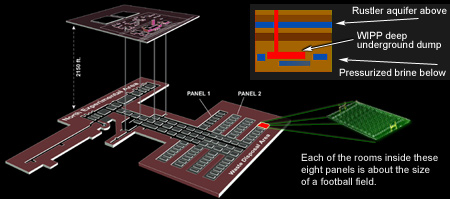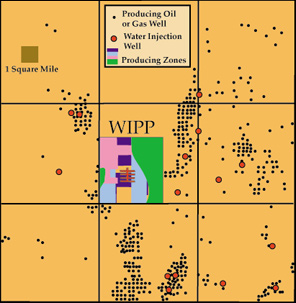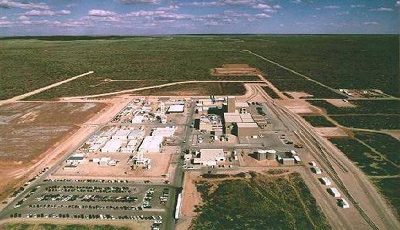Waste Isolation Pilot Project (WIPP) is a Department of Energy geologic repository which has been authorized to permanently dispose of transuranic radioactive waste in a mined underground facility located 2,150 feet (655.32 meters) below the surface in an excavated geologic salt bed. The facility is in southeastern New Mexico, 26 miles east of Carlsbad. Since 1974, when the WIPP siting was rejected in Lyons, Kansas, many New Mexican scientists and citizens have opposed WIPP. WIPP has actually been seriously considered the alternative location for a HLW geologic repository if Yucca Mountain failed, and many do not rule out the possibility. The site is operated by Westinghouse and Bechtel under the management company Westinghouse TRU Solutions. [Westinghouse TRU Solutions recently changed its name to Washington TRU Solutions]

WIPP, under the Rustler aquifer. Eight "panels" are made up of six giant storage rooms. Each room in a panel is about the size of a football field. |
Many Environmental Flaws
Just above the ceiling and below the floor of the waste rooms are anhydrite (shale-like) layers that can fracture. Fractures have caused ceilings to collapse and floors to buckle. The rooms were mined during 1986-1988, and independent experts have testified that the ceilings of these rooms could collapse at any given time, and that the rooms were only safe for five years after being dug. The DOE, however, continues to maintain that these rooms will hold together for as long as they need them to. Panel 1 already began to collapse and was sealed afterward.
The geology at the site is characterized by karst, including underground channels through which water may rush unpredictably. The facility rooms are placed beneath the Rustler aquifer, which downstream feeds the Pecos River. In addition, underneath the facility rooms is a highly pressurized brine reservior which has raised some very serious concerns. Small boreholes would not remain sealed for more than 200 years, providing a pathway for waste to escape. The DOE made claims that no brine was present at the site. In 1981, to verify this statement, independent scientists drilled a hole one mile north of the main shaft at WIPP. Pressurized brine spurted out, and 1.4 million gallons flowed out forming a small lake.
Salt, Brine, and Radioactive Waste
In 1956, The National Academy of Sciences (NAS) proposed that in a geologic disposal facility, salt would be an ideal medium which would fill in holes and surround canisters, containing heat. This formed the basis for siting such a facility, and in 1969 the search began for a such an site to accomplish the task of isolating the transuranic weapons waste of the DOE. Unfortunately, NAS came to this conclusion of a based on an assumption that "salt is always dry," and did not account for the presence of brine.
During the 1970s, the proposal for a disposal facility in the Delaware Basin was rejected due to concerns over brine seepage. Brine is now known to be attracted to heat, and the 55-gallon drums which contain the waste are at increased risk to rust and corrode. This would not only leak waste into the brine, but would also release gas which can transport waste through the interbeds and up shafts or drill holes to the Rustler aquifer and the surface. The DOE continues to publicly state that the storage areas are dry at WIPP, however, during its first Environmental Assessment's suitability testing, fans were being used to evaporate water off the walls. Not only do DOE documents discuss the problem and the use of magnesium oxide to absorb water, but bags of magnesium oxide accompany all waste drums as a partial preventative measure, as they are aware that this is not a solution to the water problem.

The small bags hanging from the waste canisters contain magnesium oxide, which is used to absorb water. Despite denying any presence of water at the site, WIPP staff have also been spotted online seeking vendors for water wall shields to emplace along the walls and guide water into floor canals. |
What is Transuranic Waste?
Transuranic waste is not simply made up of materials that appear after uranium on the periodic table, as the name implies. Transuranic waste (TRU) is defined as waste which is not high-level waste, that consists of transuranic isotopes with half-lives greater than twenty years, yet also radiates more than 100 nanocuries per gram (nCi/g). Nationally, this is much greater volume of waste than prior to 1984, when the definition of TRU waste was revised raised from 10 nCi/g to 100nCi/g. TRU is further separated into two main types: contact handled (CH-TRU) and remote handled (RH-TRU). Whereas CH-TRU can be handled in containers, RH-TRU is so extremely radioactive and more comparable to high-level waste that must be remotely handled by machinery.
All transuranic waste originates from DOE facilities, since it is a DOE-specific category of waste. Waste which falls under the definition of transuranic waste which comes from outside of the DOE is classified as "low-level" and is generally Class C or Greater-than-Class C (GTCC). Remember that being called "low-level" only means that it doesnt fall into the other categories like high-level waste or transuranic.
Hazards of Transuranic Waste Shipping Containers
Shipping containers for transporting transuranic waste on the highways are called TRUPACTs. The safety of the TRUPACT-II containers has come under scrutiny for a number of reasons. The majority of the tests conducted by the NRC were computer simulations, and not actual tests. One actual test included dropping a canister 30-feet into concrete. In the first two of these tests, the outer shell had breached. Although the DOE estimates that 40% or more of the contents of a TRUPAC container will be combustible materials, there were no tests done to determine the effects of an internal fire.
Shipments to WIPP will cross 22 states. Initially, 1450 shipments a year were estimated to arrive at WIPP, and that rate has nearly been reached. In August 2001, WIPP reached 14 shipments a week, and for 2002 expects to reach at least 24 shipments a week. From the 38,089 TRUPACT shipments scheduled over the next 35 years the DOE has estimated that 6 deaths and 48 injuries would result from accidents, and that an additional 3 people would die from radiation exposure. Since the DOE doesnt consider an accident will release radioactivity these numbers are expected to be much higher. Rail transport has been estimated to result in 10 times lower exposures to the public, and 100 times lower doses to workers than the truck shipments, but trains are not being considered for use in WIPP shipments. Property values near waste shipment routes also drop- in a jury award upheld by the New Mexico Supreme Court, the lost value of a property adjacent to the Waste Isolation Pilot Plant transportation route was at 4.75%, even before waste shipments began.

The transport containers on the left, called TRUPACTs, have been travelling over Texas highways to WIPP since 1998. RH-72's containers (on the right) resemble high-level waste casks and contain remotely-handled transuranic waste (RH-TRU), will be added to the transport routes in 2003. |
Regulatory Bodies Not Taken Seriously
Since the beginning, WIPP has experienced repeated setbacks due to it's unsuitability. The DOE has been attempting to ship waste since 1988, however, for years it didn't meet the EPA siting characterization requirements. Loopholes exempted DOE from regulation in many instances. For example, for a long time, WIPP was labled as an experimental facility, and as such was exempt from EPA and NRC regulation. It was also exempted from the Hazardous Waste Act (implying it was operating as an unlicensed facility) and exempted from State Veto power.
On May 15, 1998, the New Mexico Environment Department (NMED) issued its draft Resource Conservation and Recovery Act (RCRA) permit for WIPP and opened a 90-day public comment period. A permit was not officially issued until October 27, 1999. Although DOE repeatedly promised that it would never send waste to WIPP until a NMED permit was granted, the facility received its first shipment of wastes on March 26, 1999 from LANL. On April 28, 1999 WIPP accepted its first out-of-state shipment from INEEL. In total, DOE rushed 44 shipments of TRU waste to WIPP before the NMED was able to issue its permit. DOE argued that all of these shipments were "purely" radioactive with no hazardous constituents, hence not subject to state regulation. The NMED was never able to fully verify this.
Much of this waste ended up in Panel 1, which consists of the first seven football-field size underground disposal rooms mined at WIPP during 1986 and 1988. Panel 1 has specifically been the focus of concern over dangers of large-scale ceiling collapses that have occured at WIPP, and millions of dollars has been spent supporting this room which many feel should be abandoned. Since the waste was emplaced in Panel 1 prior to obtaining a permit, NMED and DOE have signed an agreement that no mixed wastes would be placed in that area, which the DOE has sued to overturn.

|
Drilling Hazards at WIPP Dozens of oil and gas wells are within 2 miles of the WIPP site boundary. If drilling for proven reserves of oil and gas hits the waste rooms, massive amounts of radioactivity will come to the surface. For example, drilling with air compressors can release enough radioactivity to violate health and safety standards within 10 seconds. Future drilling could additionally bring radioactive brine to the surface and into the upper aquifer, which would flow into the Pecos River and the accessible environment. Companies also inject fluid to increase oil production. Fluids have moved for miles through the interbeds, and scientific studies show that large amounts of waste could be transported offsite, even if the injection occurs outside of the site boundary. |
WIPP Too Expensive and Not a Solution for TRU Waste
Although the DOE calls WIPP the cornerstone of it's strategy to clean up nuclear weapons sites, WIPP is designed to handle less than 2% of the existing volume of nuclear wastes created by atomic bomb production, and about 32% of existing TRU waste (65,600 cu meters of 208,100 cu meters). All of the storage sites that would send waste to WIPP have larger volumes of waste that would not go to WIPP and for which there is no disposal site. By radioactivity, WIPP would handle about one-tenth of a percent of the DOE's existing wastes.
The DOE has no plans for the majority of it's TRU wastes which will apparently remain in shallow trenches at sites in Idaho, Washington, Tennessee, South Carolina, and New Mexico. These sites will be operating for decades and should focus on improving the safety of their own operations. For example, Rocky Flats is to close, but will take years, and some Colorado citizen groups advocate safer storage rather than opening WIPP. In 1994 dollars, WIPP cost totals $19 billion. Storing where it is would be about $2.7 billion. The $16 billion difference could provide significant cleanup and safer storage throughout the DOE complex.
At present, out of 27 large and small quantity sites, only five are shipping TRU wastes to WIPP. These are the Hanford, INEEL, LANL, Rocky Flats, and the Savannah River Site. Out of these five, only Rocky Flats and INEEL are sending waste to WIPP on a regular basis. To bring into perspective the fact that only two sites are now regularly shipping TRU wastes, WIPP's current (FY 2002) budget is $192,670,000 (that's $16,055,833/month) and last fiscal year s budget was $190,886,000 (that's $15,907,167/month). All this money has been and will be spent on into the future to cleanup less than two per cent of the radioactive wastes in the nuclear weapons complex.
According to DOE plans, Remote Handled waste will be disposed at WIPP starting in FY 2003; WIPP will be filled to capacity (175.6 thousand cubic meters) by FY 2033; All WIPP dismantlement and decommissioning will take 5 years (FY2034-FY2038); Active institutional controls will be implemented in FY2039 and last for 100 years.

|
Other Internet Resources on WIPP
For much more information on WIPP, please visit the following websites:
• Southwest Research and Information Center
• NukeWatch, New Mexico
• Citizens for Alternatives to Radioactive Dumping
• Concerned Citizens for Nuclear Safety
• Environmental Evaluation Group of New Mexico